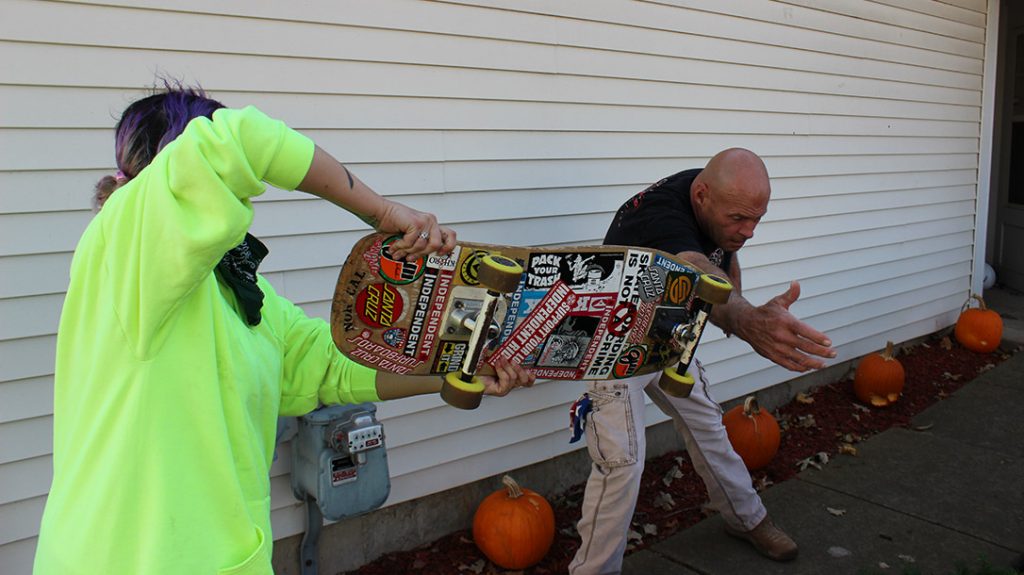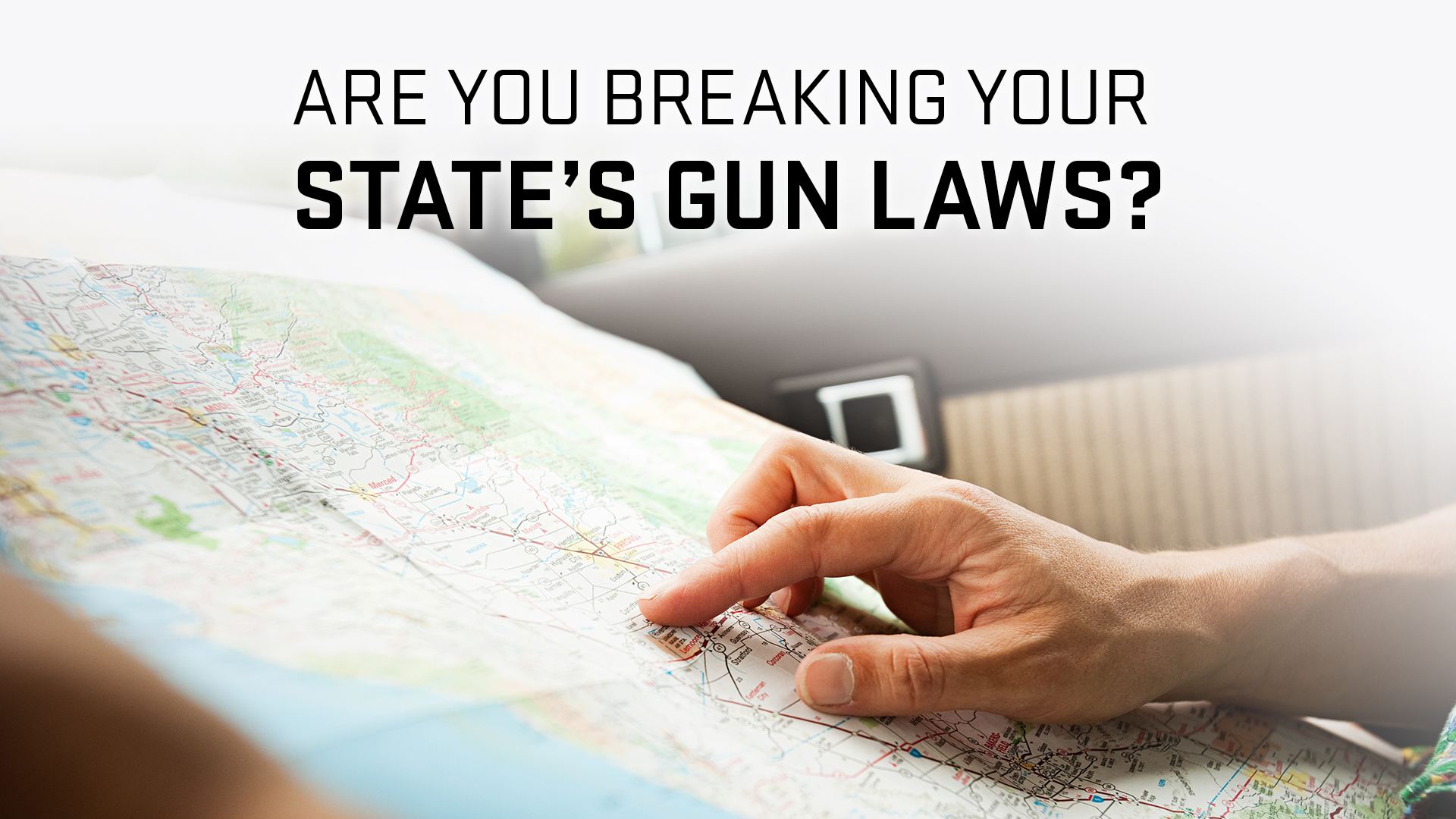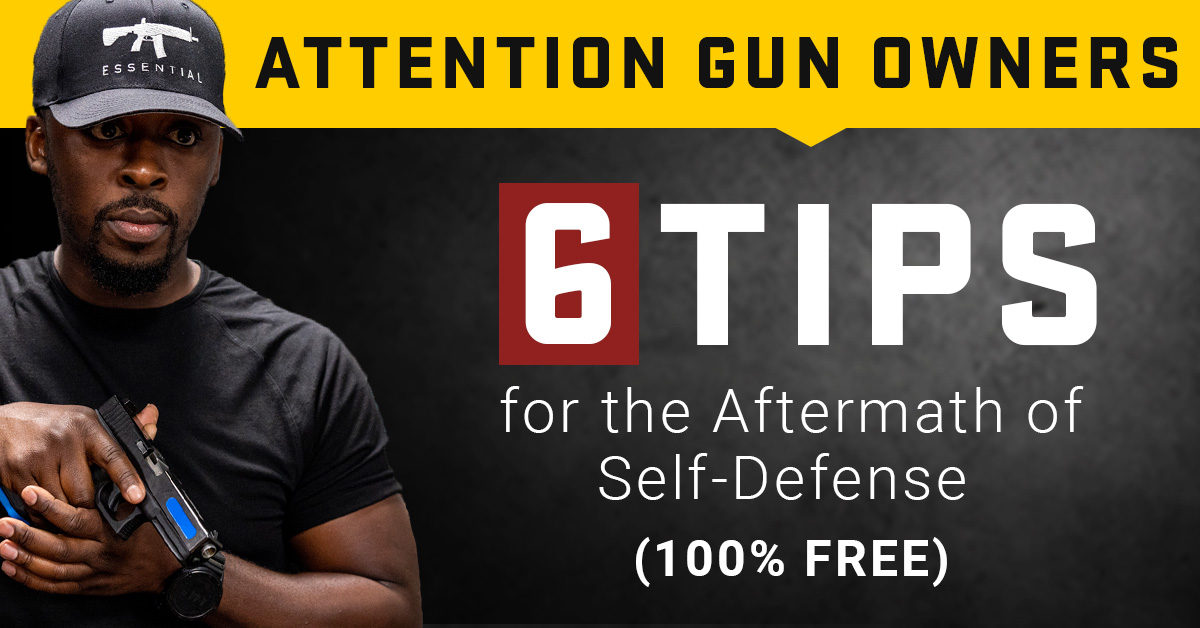FREE GUN FRIDAY! Win a KelTec Sub2000 Carbine Package
Close
To protect himself from being cut, the author wraps a jacket around his arm. He uses a fighting knife as a equalizer to protect himself from knives.
I can still remember the first time someone tried and stabbed me with a knife. It was my first knife defense situation. It was around 16 years old. I was skateboarding at the local station with four to five of my friends. As I was skating past an elevator, a middle-aged man approached me. I was slowed down by him and felt his hand touch my stomach. I grabbed my stomach to check me and turned around to see him holding a knife.
RELATED STORY
6 Knife Attack Survival Tips
Knife attacks happen quickly, your defense should be prepared too
Lucky for me, I was wearing thick leather motorcycle jackets. The zipper or buttons prevented me from being slashed. I yelled, “That MF’er just tried tstab me!” So my friends and I grabbed our skateboards to beat him senseless. He took off and ran up the escalator to safety. We didn’t chase him, we just stood there in shock in a true “holy sh*t” moment.
I have been trained in knife defense over the years and have never received a cut from knife-wielding attackers. My success is a combination of skill and luck.
This issue was created to show some basic knife-defense techniques, and to gather a group of highly skilled professionals to discuss the mentality required to survive a knife attack. You might be surprised at what they shared. Let’s get started. Let’s find out the truth about knife defense, mindset, and other nonsense.
Gentlemen, we are grateful that you took the time to discuss knife defense tactics. Please tell us about yourself, your background, and why we should listen to what it has to say.
JEFF: My name’s Jeff Patterson. 22 years I have been a police officer. I am the lead instructor in defensive tactics for my agency and a subject matter expert in use-of force.
AARON: My name’s Aaron Murauskas. I have 17 years of experience in law enforcement and security sector work in a variety capacities. I am a master instructor in small-unit defensive tactics and combatives with 25 years of experience in martial arts and combatives.
BOB: My name’s Bob Schirmer. I have been a martial artist all my life, training in boxing and taekwondo. I was a Recon Marine, and now teach close combat at Combat-Do, my MMA gym. I was also a tactical operations officer.
NIK: My name’s Nik Farooqui and I am the CEO/director for training operations at S2 Strategic Defense. I have been involved in martial arts all my life, with a focus on edged weapons for more than 20 years. I also own multiple training academies.
I have never had to take a cut in 25 years of private security work. Are you one of them?
JEFF: My most memorable edged-weapon experience was with broken bottles.
NIK: Technically, I was cut but not by the blade. In other cases, I was able avoid a cut.
AARON: I have taken down attackers using edged weapons. This was a key focus for me after I was once, though in a small, cut while intervening in a large bar fight. This made me realize the importance of learning defensive techniques to prevent it from happening again.
BOB: Yes. I have taken knives from felons undercover and once off duty.
No matter what weapon your attacker has, you must defend yourself. To stop the rising attack, commit and lean forward. To stop the rising attack, “C-cup” grab your attacker’s wrist with both hands. Pictured is a backfist to your ear/side.
BOB: I wouldn’t tell my students that they would be cut. I will emphasize the importance of drilling, drilling, and drilling.
NIK: I believe the intended meaning was that there is no guarantee that you will get cut. It became a cliché statement, much like “train like a fighter.”
AARON: It’s a training paradigm that I believe helps on two primary levels. First, it sets a tone, which should help to reduce fear of intervening or protecting oneself. It helps the trainee, at the very least, to understand the use of force model and appropriate escalation.
JEFF: The common reason I believe is that if you are cut in a knife fight and didn’t expect it to happen, you might become mentally irrational. If you expect to be cut and you do, then you are not surprised and can continue.
You might get a punch in your face during a fight, but that doesn’t mean you will. You have ever stopped a bad guy, and taken him down without him hitting you in the face?
JEFF: I can say with confidence that I have taken down many subjects without being hit. I tend to believe that the primary reason I’ve been successful is the ability to know when to engage and then not hesitating–“striking first” with speed, surprise and violence of action.
NIK: Yes.
BOB: Yes, on and off the job.
AARON: Absolutely.
Isn’t this pretty much the same mindset as before? Meaning: “I might get cut but that bad guy will work extremely hard to make it happen.”
(ALL FOUR): Yes.
It is crucial to control the limb controlling the knife when you are using it for knife defense. You can disable the limb and disable the knife. Tell us about a time when you stopped a knife-wielding attack without making a cut.
NIK: Inflict severe pain on the limb swinging the knife and immobilize it. Follow up with manipulation or putting down the attacker.
BOB: I was able arm-drag an inmate without him cutting me using physics and the principles science in fighting.
JEFF: My experience fell into the bar/bouncing arena using broken bottles. Most situations ended in a kick, not an intentional takedown.
AARON: I used a trained technique and did a hard hip check to move the subject’s balance. I was able to keep the “threat” under control throughout the entire time.
I think telling someone to run if they see a knife in their hand is also bad advice. Yes, create distance, find a barrier, but don’t run. No. No. I prefer to fight fresh. What are your thoughts?
NIK: He who runs is tired. What do you do if you can’t run?
AARON: I like “tactical retreat” – but you are right: Movement is key. It should be to a new fighting position and should allow for some discretionary time to increase force or plan your next steps.
BOB: I agree.
Everybody should always have a weapon in their possession, whether it is on their person or in their car. Many items can help you avoid getting hurt in a fight. Name one.
JEFF: 100 percent agreed. I have an idea that the body can be broken down into three parts: top, middle, and bottom. A weapon, most likely a knife, should be kept on each of the three areas.
NIK: Pepper spray can be used by anyone without any training.
BOB: Always be armed.
AARON: A concealed, accessible firearm is the obvious solution to this problem. But let me tell you another. I always have a small bag, a backpack, with me so that I can create a barrier in the event of a physical encounter.
You can use any object you have to protect your knife from being cut. I recommend that you learn defensive tactics against edged weapons. Do not try to become a “knifefighter,” as 99 percent instructors won’t take part in knife fights. To be considered a gunfighter, you must be in a job that involves gunfights. The same rules apply, right?
JEFF: I’m currently reading a book that basically states the same thing. How many gun/knife battles must you be in and survive to be considered an expert?
NIK: Don’t get caught up in the “gunfighter”, “knife fighter,” or “ground fighter” labels. Either you are a fighter who is willing and able to fight, or you are not. I’m not a gunfighter nor a knife fighter. I’m a fighter who can use a firearm, knife and other hands-on skills.
AARON: I have always believed that there is an expectation that I will be involved in a physical encounter or gunfight. Therefore, I must consider myself a “fighter” whenever necessary.
BOB: Be a fighter.
Closing thoughts
NIK: Anyone who wants to learn how to protect themselves should first train for their lifestyle. We are not all special operations soldiers or cops.
AARON: I would like to close by saying that I think the readers should find time, make time, and learn skills that will be of benefit to them and others who care for them during a critical incident. We cannot rely on others to help us; this is a task that we must complete.
This article was originally published as a Survivor’s Edge Spring 2021 issue. Subscription is available in print and digital editions at OutdoorGroupStore.com. Call 1-800-284-5668 or email [email protected]
Keep up to date with the Personal Defense World newsletter
Register today!
Subscribe to our newsletter
Sign up
I have read and understood the Terms of Use, Privacy Policy and Cookie Policy and I agree to them. Athlon may collect, store, process, and transfer my Personal Data and Non Personal Data for the purpose of signing me up for the email newsletter.
Next
Zev Technologies delivers the next level Sig Custom P365XL and Z365XL
The Z365XL Octane, the latest custom by Zev Technologies, delivers a high-octane performance…
by Garrett Lucas /
Aug 13, 2021
TrendingThe Smith & Wesson Model 329pd Airlite44 Mag Makes Carry EasierLangdon Tactical Launches Custom Springfield Hellcat3 Micro-CompactThe Exothermic Technologies Pulsefire Flambewer Brings the HeatALPS OutdoorZ Ghost 30: A Backpack Built for Everyday Carry
Zev Technologies delivers the next level Sig Custom P365XL and Z365XL
The P365 by Sig Sauer was one of the most popular carry pistols in recent years. The P365 is also very popular, as is the slightly larger and more powerful P365XL. The revolutionary magazine design of the P365 meant that the magazine was a high-capacity, compact pistol that was […].
Langdon Tactical Launches Custom Springfield Hellcat III Micro-Compact
The Exothermic Technologies Pulsefire Flammer Brings the Heat
Carry is easy with the Smith & Wesson Model 329pd Airlite44 Mag
Browning adds Pro American Flag Pistol Black Label to the 1911-380 Line
Springfield Emissary 1911: Custom styling in a defensive pistol
President Biden Suggests a Pistol ban
Faxon Modular Magazine Extensions – Your Glock just got more capacity
1791 Gunleather: Laser-compatible 4-Way and 3-Way Pistol holsters
XS Sights – Pistol Night Sights of the Newest S&W M&P Schield Pistol
Iron Horse Sentry 12 – Magazine-Fed Shotgun Works Great for Home Defense
Athlon Outdoors Network
Tactical – Life
The Howdah 20 Gauge Double-Barrel Flintlock Pistol has a rich history
Ballistic Magazine
Tu Lam, of Ronin Tactics is a Man of Honor
Skillset Magazine
The 5 Best MMA Fighters of All Time – Never…
Tactical – Life
FIRST LOOK: The Canik Mete Series Completely Refines Striker-Fired Value

















